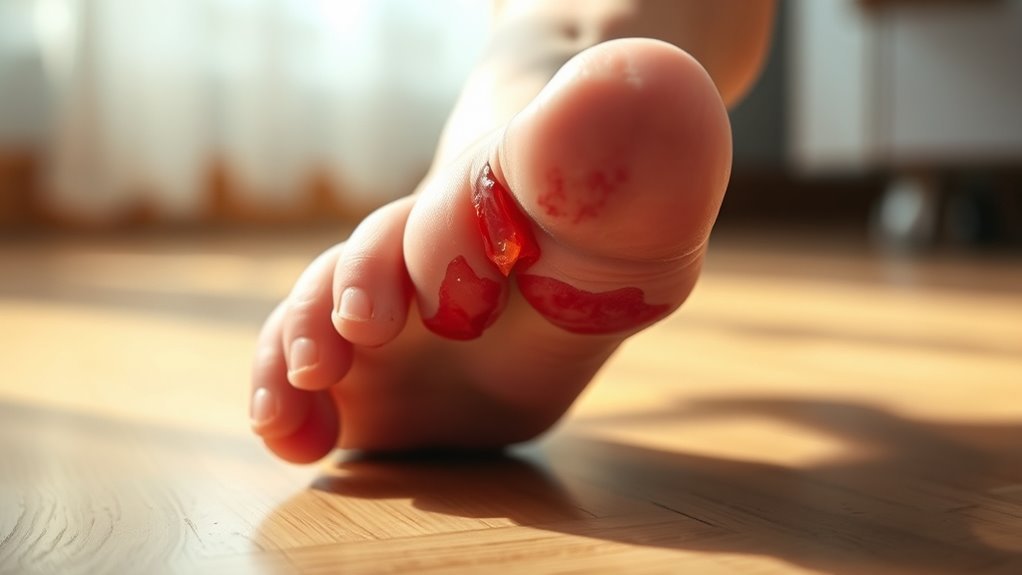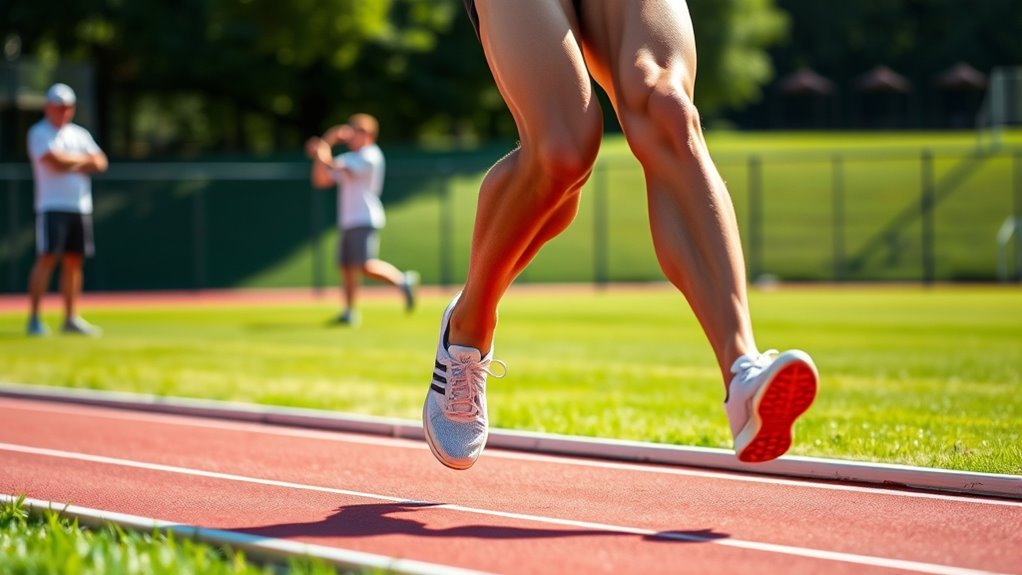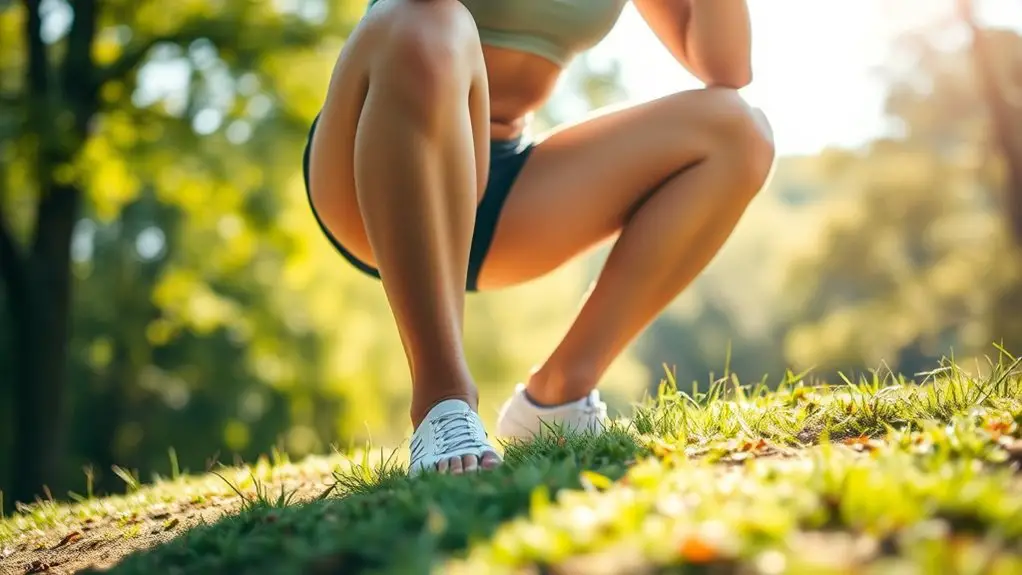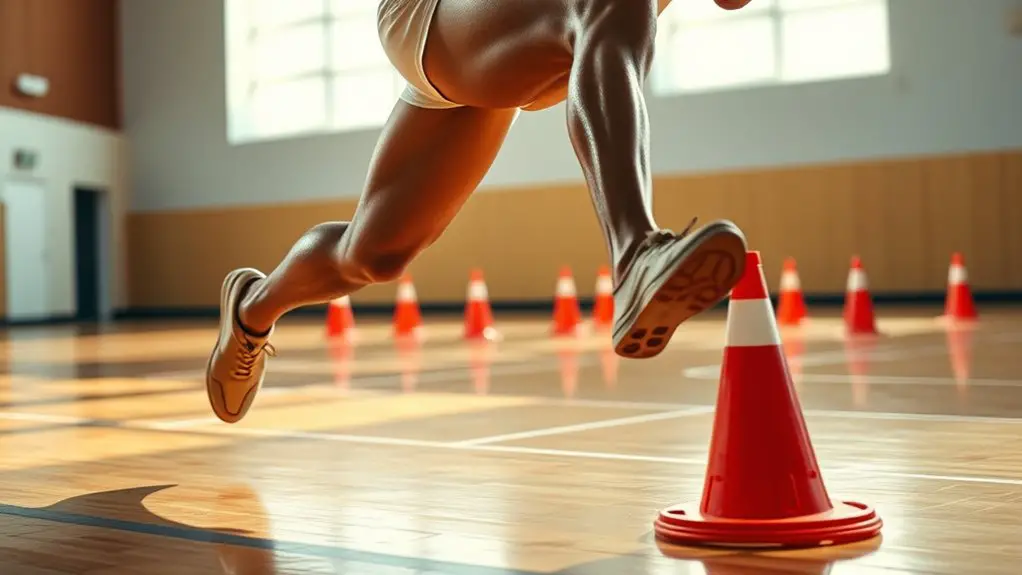Yes, athlete’s foot can hurt. You might experience mild itching or sharp discomfort, depending on the severity of the infection. Common symptoms include burning sensations, redness, and cracked skin, which can disrupt your daily activities. As the condition worsens, it may lead to increased irritation and pain. Managing these symptoms is essential for your well-being. To learn effective strategies for pain relief and when to seek medical help, keep exploring.
What Is Athlete’s Foot?
Athlete’s foot is a common fungal infection that affects the skin on your feet, particularly between the toes. This pesky skin condition often thrives in warm, damp environments, making it easy to catch if you’re not careful. You might notice itching, burning, or even peeling skin, which can be frustrating and uncomfortable. The good news is, you’re not alone in this fight for healthy feet, and reclaiming your freedom from discomfort is possible. By understanding what athlete’s foot is, you can take proactive steps to protect yourself. Keep your feet dry and clean, and don’t hesitate to seek treatment if symptoms arise. Your feet deserve to feel free and unhindered, so don’t let a fungal infection hold you back.
Causes of Athlete’s Foot
Fungi thrive in warm, moist environments, making certain conditions ripe for athlete’s foot to develop. You’ve probably noticed that this fungal infection often occurs in places like locker rooms or public showers, where humidity levels are high. If your feet sweat a lot, you’re also at risk; the moisture creates a perfect breeding ground for these fungi. Wearing tight shoes or damp socks can exacerbate the issue, leading to skin irritation. If you walk barefoot in contaminated areas, you might pick up the infection without even realizing it. Understanding these causes helps you avoid athlete’s foot and live freely, without the discomfort that comes from this pesky issue. Taking preventive measures can keep your feet happy and healthy.
Common Symptoms of Athlete’s Foot
When you have athlete’s foot, you’ll likely notice several common symptoms that can be quite uncomfortable. It often starts with itching and burning between your toes, and you might see redness or peeling skin. Blisters can form, leading to more irritation and discomfort. As the infection progresses, you may experience cracking skin, which can be painful. Don’t ignore these signs; knowing your treatment options is key. Over-the-counter antifungal creams or sprays can help ease your symptoms. To avoid future flare-ups, consider effective prevention methods like wearing breathable footwear, keeping your feet dry, and not sharing shoes or towels. Taking these steps can help you reclaim the freedom to enjoy your activities without the nagging discomfort of athlete’s foot.
How Athlete’s Foot Affects Daily Life
Dealing with athlete’s foot can markedly disrupt your daily life, especially if you’re active or on your feet often. You might find yourself making lifestyle adjustments, like avoiding certain activities or changing your footwear, which can feel limiting. The constant itch and discomfort can not only affect your physical activities but also your mental well-being. You may feel frustrated or embarrassed, which adds an emotional impact that lingers throughout your day. Whether it’s skipping a gym session or hesitating to join friends for a hike, the effects ripple through your routine. Finding freedom from athlete’s foot is essential, allowing you to reclaim your daily activities and enjoy life without the nagging reminder of this pesky condition.
Pain Levels Associated With Athlete’s Foot
If you’re dealing with athlete’s foot, you might notice a range of symptoms that can vary in severity. The discomfort can be mild, like occasional itching, or it can escalate to sharp pain that makes walking difficult. Understanding these pain levels can help you manage your symptoms more effectively.
Common Symptoms Experienced
Although athlete’s foot is primarily known for causing discomfort, the pain levels associated with this fungal infection can vary considerably. You might experience itching, burning sensations, or even redness between your toes. Peeling or cracked skin can also occur, adding to the irritation. While these symptoms can be bothersome, they often don’t lead to severe pain. It’s essential to address athlete’s foot promptly, as ignoring it can worsen the symptoms. Treatment options like antifungal creams or powders can effectively relieve discomfort and speed up healing. Additionally, adopting prevention strategies, such as keeping your feet dry and wearing breathable footwear, will help you avoid future flare-ups. With the right care, you can reclaim your freedom and enjoy your daily activities again.
Severity of Discomfort
While athlete’s foot can cause discomfort, the severity of pain associated with it can vary considerably from person to person. For some, the itching and burning may be mild and manageable, while others might experience intense pain that disrupts daily activities. If you find yourself struggling with more severe symptoms, it’s essential to explore pain management options that work for you. Over-the-counter antifungal creams can provide discomfort relief, and keeping your feet dry and clean can help prevent aggravation. Remember, you have the freedom to seek out the treatments that make you feel comfortable and in control. Don’t hesitate to consult a healthcare professional if the discomfort persists; they can guide you towards effective solutions tailored to your needs.
Tips for Managing Pain and Discomfort
When dealing with athlete’s foot pain, it is crucial to find effective ways to alleviate discomfort so you can continue your daily activities without interruption. Here are some tips for pain relief through home remedies:
| Home Remedy | Benefits |
|---|---|
| Cold Compress | Reduces swelling and numbs pain |
| Epsom Salt Soak | Relaxes feet and eases soreness |
| Tea Tree Oil | Antifungal properties relieve itching |
| Aloe Vera Gel | Soothes irritated skin |
| Vinegar Rinse | Balances pH, combats fungus |
Using these remedies can help you regain your freedom and enjoy life without the constant annoyance of pain. Don’t let athlete’s foot hold you back; embrace these simple solutions for a more comfortable day!
When to Seek Medical Attention
Not every case of athlete’s foot can be managed with home remedies, and there are times you should consider seeking medical attention. If you notice persistent pain, swelling, or redness, it’s smart to consult a healthcare professional. These could be signs of complications that might require a more thorough complications overview. If your symptoms worsen despite trying over-the-counter treatments, don’t hesitate to seek help. A doctor can provide you with effective treatment options, including prescription antifungal medications or topical treatments that work better than what you can find at the store. Remember, taking action early can prevent the infection from spreading or causing further issues, allowing you the freedom to enjoy life without the discomfort of athlete’s foot.
Frequently Asked Questions
Can Athlete’s Foot Spread to Other Body Parts?
Yes, athlete’s foot can spread to other body parts. You might notice skin irritation if it moves to your hands or groin. Fungal transmission often happens through direct contact or contaminated surfaces, so be cautious. If you’re not careful, it can lead to an annoying cycle of discomfort. Remember, keeping your feet dry and practicing good hygiene can help you maintain your freedom from this persistent nuisance. Stay vigilant and take care!
Is Athlete’s Foot Contagious to Others?
Yes, athlete’s foot is contagious to others, so there’s a contagion risk if you’re not careful. It spreads through direct contact or contaminated surfaces like shoes, towels, or floors. To keep things safe, follow prevention tips such as wearing flip-flops in shared spaces, keeping your feet dry, and not sharing personal items. By being proactive, you can enjoy freedom from the worry of spreading or catching athlete’s foot. Stay vigilant!
How Long Does Athlete’s Foot Typically Last?
Athlete’s foot typically lasts a few weeks to several months, depending on various duration factors like the severity of the infection and your treatment options. If you start using antifungal creams or powders promptly, you can often clear it up faster. Remember, keeping your feet dry and practicing good hygiene can help prevent it from lingering. So, take charge of your foot health, and you’ll be back to your free-spirited self in no time!
Can Athlete’s Foot Affect Toenail Health?
You know what they say, “An ounce of prevention is worth a pound of cure.” Athlete’s foot can definitely affect toenail health. Fungal infections can lead to toenail discoloration, making your nails look unsightly and even causing them to become brittle. If you don’t address the athlete’s foot, it might worsen and spread to your toenails. Taking care of your feet guarantees you maintain both health and freedom in your stride.
Are Certain Footwear Types Better for Prevention?
Yes, certain footwear types can definitely help in prevention. Opt for preventive footwear made from breathable materials, like mesh or leather, which allow air circulation and reduce moisture buildup. This can keep your feet dry and less prone to fungal infections. Avoid tight or non-breathable shoes that trap heat and humidity. By choosing the right footwear, you’re giving your feet the freedom they need to stay healthy and comfortable.




